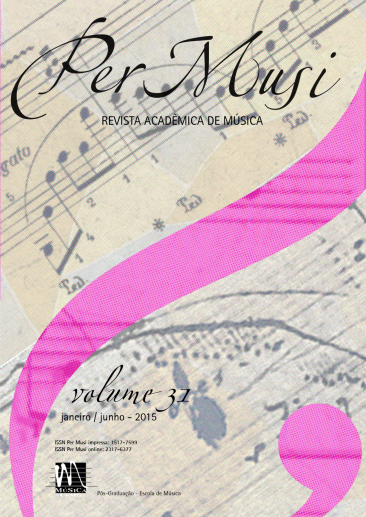Prelúdio nº 3 de Heitor Villa-Lobos
considerações sobre um processo interpretativo
Palavras-chave:
Violão, Villa-Lobos, Prelúdio nº3, Análise para intérpretesResumo
Este trabalho apresenta uma interpretação da peça para violão solo Prelúdio nº 3, de Heitor Villa-Lobos. A análise fundamenta-se nos conceitos de performance historicamente informada (WALLS, 2002) e intuição informada (RINK, 2007). Portanto, apresenta-se aqui um estudo de caso onde a intuição e percepção musical do intérprete são reforçados por aspectos estéticos e estilísticos. Primeiramente, serão abordadas características harmônicas e de ornamentação (elementos estético-estilísticos); depois, adentra-se na análise da peça, baseada em parâmetros como plano formal, temporalidade e dinâmica (RINK, 2007), bem como de agrupamentos (JACKENDOFF; LERDAHL, 1983).
Referências
DUDEQUE, Norton Eloy. História do Violão. Curitiba: Ed. da Universidade Federal do Paraná, 1994.
GOLDSPIEL, Alan. A new look at musical structure and the guitar in the music of Villa-Lobos. Soundboard Magazine, n.2, p.7-13, 2000.
GREEN, Douglass. Form in tonal music: an introduction to analysis. New York: Holt, Rinehart and Winston, 1979.
HILL, Peter. From score to sound. In: Musical Performance. A Guide to Understanding. Cambridge: CUP, p.129-143, 2002.
JACKENDOFF, Ray; LERDAHL, Fred. A generative theory of tonal music. London: MIT Press, 1983.
JAFFEE, Michael. Harmony in the solo guitar music of Heitor Villa-Lobos. Guitar Review. New York, n.29, p.18-22, 1966.
PRADA, Teresinha. Violão: de Villa-Lobos a Leo Brouwer. São Paulo: Terceira Margem, 2008.
RINK, John. Análise e (ou?) performance. Cognição & Artes Musicais/Cognition & Musical Arts. v.2, n.1, p.25-43, 2007.
SANTOS, Turíbio. Heitor Villa-Lobos e o violão. Rio de Janeiro: Museu Villa-Lobos, 1975.
VILLA-LOBOS, Heitor. Guitar Etudes. Paris: Max Eschig, 1953. Violão solo.
VILLA-LOBOS, Heitor. Cinq Préludes. Paris: Max Eschig, 1954. Violão solo.
WALLS, Peter. Historical Performance and the modern performer. In: Musical Performance. A Guide to Understanding. Cambridge: CUP, p.17-34, 2002.
Downloads
Publicado
Edição
Seção
Licença
Copyright (c) 2015 Per Musi

Este trabalho está licenciado sob uma licença Creative Commons Attribution 4.0 International License.

Exceto onde está indicado, o conteúdo neste site está sob uma Licença Creative Commons - Atribuição 4.0 Internacional.












